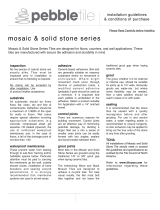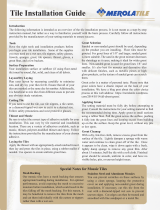Page is loading ...

WWW.SOLISTONE.COM
INFORMATION & GUIDELINES FOR THE INSTALLATION OF ATLANTIS GLASS
RECOMMENDED INSTALLATION
Atlantis Glass Mosaic tiles are designed for almost any commercial and residential interior and
exterior application including walls, ceilings, countertops, backsplashes and more. It is not
recommended for areas that may be subject to heavy impact, heavy abrasion, and areas where
temperatures can exceed 130 degrees Fahrenheit.
This mosaic is also suitable for all water features, including fountains, pools, spas, showers and
steam rooms.
NOTE: this document contains only guidelines for the installation process. A professional installer
should always be consulted to discuss the specific parameters surrounding your project.
CURVED SURFACES
SOLISTONE Atlantis Glass Mosaic tiles can be installed around gently curved surfaces. Some
manipulation of the tiles may be required in order to create uniformity between each sheet. The
glass comes with a plastic front or mesh back which can easily be cut with a utility knife.
SUBSTRATES
All substrates should be firmly fixed, flat, clean, dry and free of contaminants such as dust, oil,
paint, sealers etc. to ensure proper adhesion. Painted surfaces must be scuffed or sanded for the
product and adhesive to bond correctly. Wet areas need special attention and require
appropriate substrates, e.g. concrete, cement boards (compressed sheet), and/or treated
plywood. The use of reinforced waterproof membranes is suggested.
WATERPROOF MEMBRANES
Waterproof membranes prevent leakage of water through to the sub-floor framing and/or
habitable spaces below. Particular attention must be paid to: carrying the membrane up the wall,
outside shower boxes, installation of bond breakers, and sealing around penetrations. It is
strongly recommended that membrane systems be used in all wet areas. Some systems may
involve the use of a primer.
CUTTING
The individual glass pieces can be cut with a curved splitting clamp or a glass cutter. The mesh
back or plastic front can easily be cut with a utility knife.

WWW.SOLISTONE.COM
ADHESIVE
Follow the adhesive manufacturer’s instructions carefully. We do not recommend one brand of
adhesive over another. Please check with your local tile supply store for alternative and
comparable products.
The manufacturer's literature will explain if the adhesive product is suitable for interiors and/or
exteriors, as well as walls and floors. Most thinset mortars with a latex additive (multi purpose
and polymer modified thinsets) are adequate for installing glass. A cement-based adhesive is
generally suitable on masonry substrates where no movement is anticipated. Where slight
movement could occur through thermal or pedestrian loads, a modified cement adhesive should
be used as a minimum. A 1/4” – 1/8” notch trowel is recommended for most applications. Set the
tile in place, gently tapping it in with a grout float to ensure 100% adhesive coverage.
We recommend using a white adhesive to show the true color of the glass, if a grey adhesive is
used the color of the adhesive will show through the tile. Suggested adhesives include but are not
limited to:
Mapei: Adesilex P10 (bright white) non-sag mortar for glass tile. Mix with water or Keraply.
Mapei: Kerabond Premium Dry-Set Mortar (Ker 102) mixed with Keralistic Mortar Admix (Ker
310).
Custom Building Products: Premium Plus Thin-Set Mortar (white) mixed with Custom Flex Ultra-
Strength Thin-Set Additive.
Custom Building Products: MegaFlex Ultimate Thin-Set Mortar (white). No admixture is
necessary.
Hydroment: ReFlex Ultra-Premium Latex-Modified Thin-Set Mortar. No admixture is necessary.
Laticrete: 254 Platinum Multipurpose Thin-Set Mortar. No admixture is necessary.
TEC (H.B. Fuller): Super Flex Premium Performance Universal Latex-Modified Thin-Set Mortar.
No admixture is necessary.
Please note: the mosaic sheets should be laid as tightly together as possible. We also recommend
offsetting the sheets from row to row to prevent the appearance of seams.

WWW.SOLISTONE.COM
GROUTING
Grout should be designed for external or internal conditions, whichever may be the case. Non-
sanded grout is generally recommended for any grout joint 1/8” or smaller. Grouts are
ordinarily a water mix but where some flexibility may be needed, a latex additive or similar
product should be used. It is important to wait the interval recommended by the adhesive
manufacturer before grouting to minimize dirt ingress between the squares and avoid the
opportunity for dislodging.
In the event that one desires to better expose the individual glass pieces, it is suggested that
during the grouting process, the installer repeatedly removes the excess grout from the joints by
the use of a medium bristle brush and sponge.
SEALANTS
The glass tiles do not have to be sealed but we strongly recommend sealing the grout after
installation to help prevent it from absorbing stains.
CARE & CLEANING
SOLISTONE Atlantis Glass Mosaic tiles must be regularly cleaned and maintained to extend the
life and beauty of the tile. The glass can be cleaned with a neutral mild detergent, or glass
cleaner. Any spills should be cleaned quickly to lessen the degree of the stain to the grout. Do not
use abrasive cleaners, powders, scouring pads, steel wool or sandpaper. Do not let soap, bleach
or other cleaning solutions set on the surface.
/



